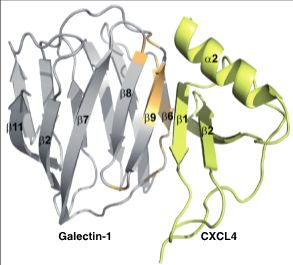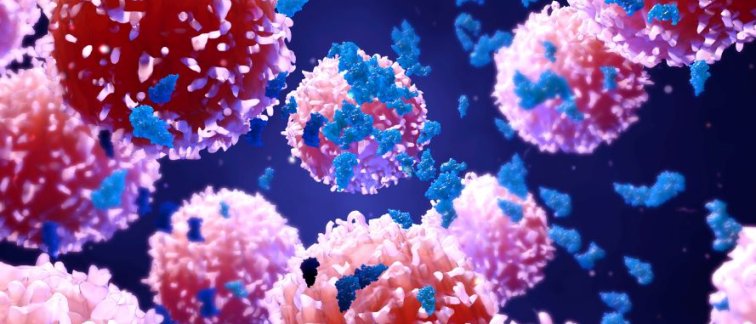Victor Thijssen, Associate Professor of Radiation Oncology and Cancer Biology explains: “Galectins are carbohydrate-binding proteins that can kill immune cells and thereby inhibit anti-tumor immunity. To do this, galectins have to bind to specific glycans, complex sugars, on the immune cell surface. Based on our previous work, we hypothesized that chemokines, small proteins that are secreted by cells into the microenvironment, can modulate the immunosuppressive activity of galectins.”
Tumor ammunition and immune cell defense
Using a protein interaction screen, the researchers identified different galectin-chemokine binding pairs. “We focused on a specific pair consisting of galectin-1 and the chemokine CXCL4 and found that the interaction with CXCL4 changes the galectin-1 protein structure,” says Dr. Thijssen. “The structural alterations affect how strong - and to which - glycans galectin-1 can bind. In our lab, experiments showed that the interaction with CXCL4 enhances the ability of galectin-1 to kill specific immune cell subtypes.
“At the same time, another galectin-chemokine pair, i.e., galectin-9/CCL5 reduces killing of certain immune cell subtypes. Collectively, these results indicate that tumor cells exploit the presence of chemokines in the tumor microenvironment.”
Turning the table
The discovery that specific chemokines can directly bind to immune-destructive galectins, and that this interaction alters the binding of galectins to glycans, adds a mechanistic layer that could potentially be exploited to enhance immunotherapy effectiveness. Dr. Thijssen: “By altering the expression and secretion of galectins, tumor cells might shape the anti-tumor immune response to their benefit. Further research should reveal to what extent this mechanism contributes to immune evasion by tumors and whether it can be targeted to improve (immuno)therapeutic strategies.”
 Figure. Structure and association of the galectin-1 protein with the chemokine CXCL4.
Figure. Structure and association of the galectin-1 protein with the chemokine CXCL4.
For more information, read the scientific publication in Communication Biology or contact
Dr. Victor Thijssen: v.thijssen@amsterdamumc.nl
Reference: Sanjurjo, L., Schulkens, I.A., Touarin, P. et al. Chemokines modulate glycan binding and the immunoregulatory activity of galectins. Commun Biol 4, 1415 (2021).
Researchers involved affiliated with Cancer Center Amsterdam: Lucía Sanjurjo*, Iris A. Schulkens*, Roy Heusschen*, Ed Aanhane*, Kitty C. M. Castricum*, Tanja D. De Gruijl,
Arjan W. Griffioen & Victor L. J. L. Thijssen.
*Former Amsterdam UMC, currently employed elsewhere.
Funding: This research was in part funded by the Dutch Cancer Society (KWF).
Text adaptation by Henri van de Vrugt

